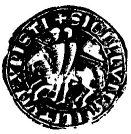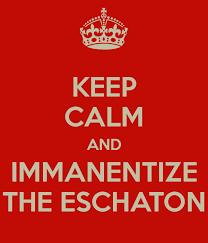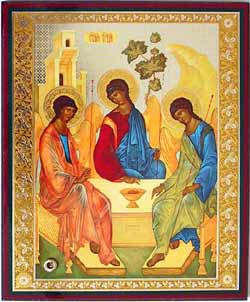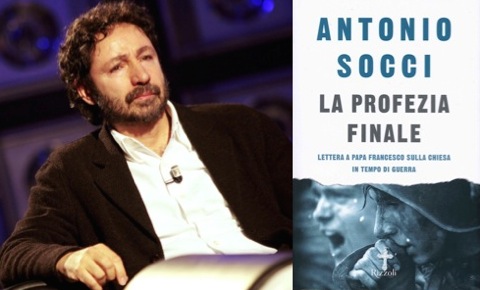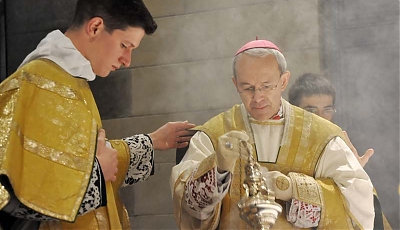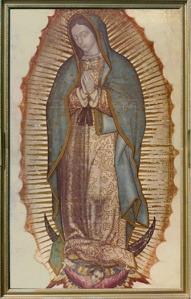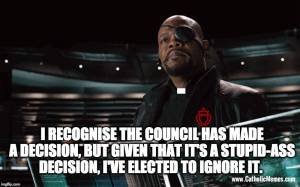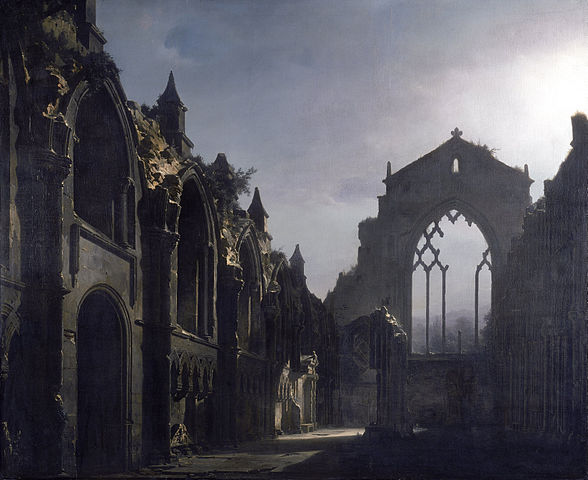With thanks to Rorate Caeli
Prof. Roberto de Mattei
1.The infallibility and indefectibility of the Church
The Church has been through the gravest crises in the course of Her history: external persecutions like those which characterized the first three centuries of Her life and since then have always accompanied Her; internal crises, such as Arianism in the fourth century and the Great Western Schism. However, the process of the Church’s “self-demolition” “struck by those who belong to Her” which Paul VI spoke of as far back as 1968[1], appears to be a crisis without precedent because of the extent and depth of it.
We say this in a spirit of deep love for the Papacy, rejecting every form of anti-infallibility, Gallicanism and conciliarism; in a word, every error that would diminish the role and mission of the Papacy. We profess with the entire Church, that there is no higher authority on earth than that of the Pope, since there is no mission or office more elevated than his. Jesus Christ, in the person of Peter and his successors conferred to the Roman Pontiff, the mission to be the visible head of the Church and His Vicar[2]. The dogmatic constitution Pastor aeternus of the First Vatican Council defined the dogmas of the Roman Primacy and papal infallibility[3]. The first asserts that the Pope has supreme power of jurisdiction, both ordinary and immediate, over individual Churches, individual pastors and all the faithful. The second dogma teaches that the Pope is infallible when he speaks “ex cathedra”, which is to say when in his function as Supreme Pastor, he defines that a doctrine in matters of faith or morals must be held by the entire Church.
The authority of the Pope has precise limits however, which cannot be ignored. Javier Hervada in his well-known manual on Constitutional Canon Law, writes: “The power of the pope is not unlimited: it is circumscribed within determined limits. The limits may regard the validity or lawfulness in his exercise of power. The limits regarding validity are given as: a) of the natural law: b) of the positive Divine law; c) of the nature and the ends of the Church”[4].
If the Pope oversteps these limits he deviates from the Catholic Faith. It is common doctrine that the Pope as a private doctor, may deviate from the Catholic Faith, falling into heresy[5]. The hypothesis of a heretic Pope is treated as [a]“scholion” in all theological treatises[6].
It should be emphasized that the expression “private doctor” does not refer to the Supreme Pontiff’s acts of a private nature, but to his “public” function as supreme Pastor of the Church[7]”. In his final relatio on the dogma of infallibility at the First Vatican Council, Monsignor Vincenzo Gasser (1809-1879), representative of the Deputation of the Faith, stated precisely that as a “public person” it must be understood that the Pope is speaking ex cathedra, with the intention of binding the Church to his teaching[8]. The theological hypothesis of a heretical Pope does not contradict the dogma of infallibility, since the infallibility concerns the person of the Pope only when he acts ex cathedra. Further, also those who deny that the Pope can fall into heresy admit the possibility that he can express himself in an erroneous, misleading or scandalous manner. Furthermore, if the problem of a heretic Pope poses the problem of the loss of the Pontificate, the presence of a Pope fautor haeresim[9] poses equally grave theological problems.
In order to better clarify this question, we must remember that alongside the dogma of the Roman Primacy and Papal infallibility, a third exists, not yet defined by the solemn Magisterium, but, in a certain sense, it is the origin of the previous two: the dogma of the indefectibility of the Church.
Indefectibility is the supernatural property of the Church, and thanks to this She will never disappear, but will arrive at the end of time identical to Herself, with no change in Her permanent essence, that is, Her dogmas, Rites (the Mass and the Sacraments), and the Apostolic succession of Her hierarchy. The Augustinian theologian Martin Jugie (1858-1954), in the Catholic Encyclopaedia entry dedicated to indefectibility, writes that this is a truth of the faith clearly contained in Holy Scripture and taught by the Ordinary Magisterium[10]. Modernism opposed the indefectibility of the Church, and had, and still has, theological, philosophical evolutionism as its basis[11].
Indefectibility includes not only the infallibility of the Pope, but of the entire Church. The Pope is, under certain conditions, infallible, but not indefectible. The Church, which includes the Pope, bishops and ordinary lay-people, is infallible and indefectible. Theology differentiates between essential or absolute infallibility and shared or relative infallibility: the first is God “qui nec falli nec fallere potest”[12] ; the second is the charisma from God bestowed on His Church.
From the First Vatican Council onwards the infallibility of the Pope has been discussed a lot, both affirming or denying it. Little to nothing has been said about the indefectibility and the infallibility of the Church. Yet, the combination of papal infallibility and the infallibility of the Church, notes Monsignor Brunero Gherardini, is conformable to Tradition and was confirmed by Vatican I: “Definimus Romanum Pontificem… ea infallibilitate pollere, qua divinus Redemptor Ecclesiam suam… instructam esse voluit”[13].
“Two infallibilities which are added or subtracted from each other are not at stake here, – specifies the Roman theologian – ; but [it is] the one and the same charisma, which has, in the Church, in the Pope and in the bishops, collegially considered in communion with the Pope, its lawful authority. This charisma is expressed in a positive form, prior to and perhaps more than a negative form. It is at work when the Magisterium in announcing the Christian truth or settling eventual controversies, remains faithful to the ‘depositum fidei’ (I Tim. 6, 20; 2 Tim. 1,4) or discovers new implications up until that moment unexplored”[14].
Theologians refer to the infallibility of the Church when they speak of an infallibility in docendo and an infallibility in credendo. The Church, in fact, is made up of a teaching part (docens) and a taught part (discens). It is only for the Church docens to teach revealed truth infallibly, whereas the Church docens receives and conserves this truth. However, alongside the infallibility in teaching, there is also the infallibility in believing, since neither the corpus docendi, invested with the power of teaching the entire Church, nor the universality of the faithful in believing, can fall into error. If, in fact, the flock of the faithful, as a whole, could fall into error, believing something to be of Revelation which is not, the promise of Divine assistance to the Church would be frustrated. St. Thomas Aquinas refers to the infallibility of the Church as a whole, when he affirms: “it is impossible that the judgment of the universal Church is wrong in that which is referred to the faith[15]”.
The ‘Church learning’ in so far as it believes, belongs not only to the faithful, but also to priests, Bishops and the Pope themselves, since everyone is required to believe the truths revealed by God – superiors no less than inferiors. In the Church, there is however, only one infallibility of which all Her members share in an organic and different way: each one according to their ecclesial office. Individual Christians can err in matters of faith, even when they hold the highest ecclesiastical offices, but not the Church as such – She is always immaculate in Her doctrine.
This infallibility is expressed in the so-called “sensus fidelium”[16], of which the entire people of God enjoy infallibility not only by reflex, but also pro-actively, as often they anticipate Church definitions, or contribute in making them clearer: for example, this occurred before the Council of Ephesus proclaimed the Virgin Mary as Mother of God. St. Cyril[17] and St. Celestine[18] attest that the Christian populace already acknowledged belief in the Divine Maternity as “the faith that the Universal Church professes”[19]. In the history of the Church, devotion to the Blessed Virgin was the field whereby the influence of the Holy Spirit on the faithful was manifested with force majeure.
- The sensus fidei in the history of the Church
The first author who uses the term “sensus fidei” seems to be Vincent of Lerins (who died around 445 AD). In his Commonitorium he proposes as normative, the Faith observed everywhere always and by all, (quod ubique, quod semper, quodo ab omnibus creditum est)[20]. The first historical manifestation of the sensus fidei however, may be regarded as the Arian Crisis in which, according to the careful reconstruction by Blessed John Henry Newman[21] (1801-1890), the ‘Church teaching’ appeared often uncertain and lost, but the sensus fidelium preserved the integrity of the Faith, so much so that St. Hilary was able to say: “Sanctiores sunt aures fideles populi labiis sacerdotum”[22]. Card. Newman writes: “There was a temporary suspense of the function of the Ecclesia docens. The body of Bishops failed in their confession of the faith. They spoke variously, once against another; there was nothing, after Nicaea, of firm, unvarying, consistent testimony, for nearly sixty years”. During this period, he adds, “the Divine tradition committed to the infallible Church was proclaimed and maintained far more by the faithful than by the Episcopate”[23].
All of the great modern councils have referred to the sensus fidei. The Council of Trent made appeal repeatedly to the judgment of the entire Church in defending articles in contrast to the Catholic Faith. Its decree on the Sacrament of the Eucharist (1551), for example, invokes specifically “the general consensus of the Church” (universum Ecclesiae sensum) [24]. The Dominican Melchior Cano (1509-1560), who took part in the Council of Trent, in his treatise De locis theologicis, for the first time treated the sensus fidelium extensively, defending, against the Protestants, the values Catholics recognize regarding the power of Tradition in theological argument[25].
Also the Dogmatic Constitution Pastor aeternus of the First Vatican Council, which defined the Pope’s infallible Magisterium, presupposed the sensus fidei fidelium. The original project of the Constitution Supremi pastoris, which served as the base for Pastor aeternus, had a chapter on the infallibility of the Church (c. IX)[26]. Nonetheless, when the agenda for the day was discussed with the aim of addressing the question of pontifical infallibility, the discussion of this principle was adjourned and never taken up again. In his final relatio, Monsignor Gasser, cites the example of the Immaculate Conception to show that the Pope deemed consultation with the Church necessary, before reaching the definition of the dogma. The research of Father Giovanni Perrone (1794-1876), on the patristic conception of the sensus fidelium had a strong influence on Pope Pius IX’s decision to proceed with the definition of the dogma of the Immaculate Conception[27]. In the apostolic constitution which contains the definition Ineffabilis Deus (1854), Pius IX uses the language of Perrone to describe the concordant testimony of the bishops and the faithful[28].
Like Pius IX, also Pope Pius XII, before defining the dogma of the bodily Assumption of Mary Most Holy, wanted to consult the bishops of the entire world, who, besides voicing their opinion, had to testify to the devotion of their faithful[29]. In those years, the sensus fidei, was the object of some important studies, in particular, those by Franciscan Father Carlo Balić and the Redemptorist Clement Dillenschneider, the Dominican Claudio Garcia Extremeno and the Servite Tommaso Maria Bartolomei[30].
Also the Second Vatican Council dealt with the sensus fidei or communis fidelium sensus. In particular, Chapter 12 of Lumen Gentium, asserts in fact: “The entire body of the faithful, anointed as they are by the Holy One, cannot err in matters of belief. They manifest this special property by means of the whole peoples’ supernatural discernment in matters of faith when ‘from the Bishops down to the last of the lay faithful’ they show universal agreement in matters of faith and morals. That discernment in matters of faith is aroused and sustained by the Spirit of truth. It is exercised under the guidance of the sacred teaching authority, in faithful and respectful obedience to which the people of God accepts that which is not just the word of men but truly the word of God (cf. 1 Ts. 2, 13). Through it, the people of God adheres unwaveringly to the faith given once and for all to the saints (cf. Gdc. 3), penetrates it more deeply with right thinking, and applies it more fully to life”.
The fact that at times, the progressives have used this passage to contest the ecclesiastical authorities, doesn’t mean that it is false and that it cannot be understood, like many other passages from the Council, in conformity with Tradition. It should be noted, moreover, that in the modern age the doctrine of the sensus fidei, has been explored mainly by great theologians of the Roman School, such as Father Giovanni Perrone (1794-1876) and Father Matthias Joseph Scheeben (1836-1888) Cardinals Baptiste Franzelin (1816-1886) and Louis Billot[31] (1846-1931). Cardinal Franzelin in particular, underlines the role of the Holy Spirit in forming and maintaining the conscientia fidei communis of the Christian people, and like Melchior Cano, judges the sensus fidelium, as one of the organs of Tradition, to which it is a faithful echo[32]. I am reminded of Monsignor Gherardini, the latest brilliant exponent of the Roman School, who gave me a gift in the ‘Eighties of a study dedicated to the sensus fidei, entitled Infalibilidad del Pueblo de Dios, by Don Jesús Sancho Bielsa, published by the Faculty of Theology at the University of Navarra[33]. There are other authors belonging to the same Opus Dei school who have given ample space to the sensus fidei, like the theologians Fernando Ocàriz and Antonio Blanco[34].
Nonetheless, throughout history, the sensus fidei has been made manifest in the minds and hearts of ordinary lay-people before being written by theologians, as Benedict XVI recalled with these words[35]: “Important theologians like Duns Scotus enriched what the People of God already spontaneously believed about the Blessed Virgin and expressed in acts of devotion, in the arts and in Christian life in general with the specific contribution of their thought. […] This is all thanks to that supernatural sensus fidei, namely, that capacity infused by the Holy Spirit that qualifies us to embrace the reality of the faith with humility of heart and mind.[…] May theologians always be ready to listen to this source of faith and retain the humility and simplicity of children! I mentioned this a few months ago[36] saying: There have been great scholars, great experts, great theologians, teachers of faith who have taught us many things. They have gone into the details of Sacred Scripture, of the history of salvation but have been unable to see the mystery itself, its central nucleus. […] The essential has remained hidden! On the other hand, in our time there have also been ‘little ones’ who have understood this mystery. Let us think of St Bernadette Soubirous; of St Thérèse of Lisieux, with her new interpretation of the Bible that is ‘non-scientific’ but goes to the heart of Sacred Scripture”.
3.The nature of the sensus fidei according to the teaching of theologians
In 2014, the International Theological Commission, presided by Cardinal Gerhard Ludwig Müller, Prefect of the Congregation for the Faith, published a study, entitled The sensus fidei in the life of the Church, interesting, most of all for its references to St. Thomas Aquinas[37]. In these pages it is made clear, that unlike theology, which can be described as a scientia fidei, the sensus fidei is not a reflexive, conceptual knowledge of the mysteries of the Faith, but a spontaneous intuition, with which the believer adheres to the true Faith or refuses what opposes it[38]. It therefore derives from the Faith and is a property[39] thereof. It is compared to an instinct since it is a type of spontaneous intuition which comes from the innateness (connaturality) the virtue of faith establishes between the believer subject and the object of the authentic Faith. The theologians Ocàriz and Blanco define it as the: “capacity of the believer, not only to believe what is presented to him by the Church as truth of the Faith, but also and above all the facility of discerning, as if by instinct, what is in agreement with the Faith from what is not, and also the facility of drawing greater in-depth conclusions from the truths taught by the Magisterium, not by way of theological reasoning, but spontaneously, through a sort of innate (connatural) knowledge. The virtue of faith (habitus fidei) produces in fact an innateness (connaturality) of the human spirit with revealed mysteries, so that the supernatural truth attracts the intellect”[40].
The doctrine of knowledge per quandam connaturalitatem is a form of interior intelligence that springs from the faith as instinctus or lumen fidei: St. Thomas Aquinas explains it in the Summa Theologiae, when he asserts that the “rectitude of judgment is twofold: first, on account of perfect use of reason, secondly, on account of a certain connaturality with the matter about which one has to judge. Thus, about matters of chastity, a man after inquiring with his reason forms a right judgement, if he has learnt the science of morals, while he who has the habit of chastity judges of such matters by a kind of connaturality”[41].
The reason is that the virtuous man has a stable disposition (habitus) in exercising a certain type of behaviour. The chaste man loves instinctively what is pure and in a likewise immediate manner experiences a repugnance for what is turbid and impure. This “spiritual instinct” allows him to discern how to behave in the most difficult situations and thus resolve in practice, problems which for moralists can remain abstract. “The habitus of faith – explains the Angelic Doctor – possesses a capacity whereby, thanks to it, the believer is prevented from giving assent to what is contrary to the faith, just as chastity gives protection with regard to whatever is contrary to chastity[42]”. Thus, in agreement with the connaturality that comes to him from this habit (habitus), “man adheres to the truths of the faith and not to the contrary errors, through the light of the faith infused in him by God”[43].
The supernatural capacity that the believer has in perceiving, penetrating and applying to his life the revealed truth that comes from the Holy Spirit. St. Thomas takes as a starting point the fact that the universal Church is governed by the Holy Spirit, Who, as Jesus Christ promised “will teach (Her) the entire truth” (John 16, 13)[44]. “Showing the truth –says the Angelic Doctor – is a property of the Holy Spirit, because it is love which brings about the revelations of secrets”[45].
This sense of the faith exists in all believers, including sinners, even if he who is in a state of Grace has a deeper and more intense insight of the dogmas of faith than he who is in sin; and among those who are in a state of Grace the insight is proportionate to the level of sanctity. Such insight in fact is an illumination that comes from the grace of the faith and the gifts of the Holy Spirit in the soul, especially those of intellect, knowledge and wisdom[46].
This Christian sense has nothing whatever to do with the religious sentiment of the modernist type, condemned in the encyclical Pascendi by St. Pius X and even less so with that facultas appetendi et affectandi which the encyclical Humani generis by Pius XII[47] makes mention of. The sensus fidei, in fact, is not a product of the sensibilities, but of the faith, grace and the gifts of the Holy Spirit which enlighten the intellect and move the will[48].
The Holy Spirit Who dwells in the faithful does not remain inactive. He lives in the soul, like the sun, to illuminate it. The inspirations of the Holy Spirit are a reality which can accompany the ordinary life of every Christian, faithful to the action of Grace. The Divine inspiration of the Holy Spirit, as Father Arnaldo Maria Lanz S.J. explains, must not be confused with interior revelations and locutions, which communicate new ideas through an extraordinary influence, but it is a Divine “instinct” which helps us know and act better under the influence of God[49]. “Now – writes Father Balić – this Spirit of the Seven Gifts Who dwells in us, not as in the midst of ruins, but as in a temple (1 Cor. 3, 16-17; 6, 19) is the Spirit of Pentecost; He is the Spirit of Truth (John 14, 17) whose special mission consists in revealing to the world the full substance of Christ and all the wonders the Son of God had kept hidden or had not completely and clearly revealed”[50]. Thanks to the sensus fidei the believer perceives the truths preserved in the revealed deposit [of the faith]. Like this, the promise of St. John is fulfilled: “The unction from the Holy One: that is grace and wisdom from the Holy Ghost” (1 John 2, 20).
- Sensus fidei, Magisterium and Tradition
Father Balić also calls the sensus fidei “Catholic common sense” or “Christian sense” (sensus christianus)[51]. In philosophy, ordinary common sense is the intelligence and natural light which men are normally endowed with: a quality which permits the understanding of the notions of good and evil, true and false, beauty and ugliness[52].
“Catholic common sense”, is the supernatural light which the Christian receives at Baptism and Confirmation. These sacraments infuse us with the capacity to adhere to the truths of the faith through supernatural instinct, even before that of theological reasoning.
In the same way that common sense is measured by the objectivity of the real, the sensus fidei is measured by the objective rule of the truths of the faith contained in the Church’s Tradition. The proximate rule of the Faith is the infallible Magisterium of the Church, which is the task only of those, by Christ’s will, who have the right and the office to teach: the Apostles and their successors. The mass of the faithful have no part in this official teaching, and is limited to receiving it. “They would err, however, – writes Father Balić – those who think that this mass is in a merely passive and mechanical state in regard to this doctrine. And in fact the faith of the laity, like the doctrine of the shepherds, is sustained by the influence of the Holy Spirit, and the faithful by their Christian sense and profession of Faith, contribute to the exposition, publication, manifestation and testimony of the Christian truth”[53].
The faithful, although they have no mission to teach, have the function of preserving and propagating their faith. The theologians Ocàriz and Blanco write, citing Cardinal Franzelin: “The infallibility of the ‘sensus fidei’, manifested by the ‘consensus fidelium’ exists even when it refers to a truth not yet infallibly taught by the Magisterium. In this case the ‘consensus fidelium’ is certain criteria of truth since it is criterion ‘divinae traditionis’”[54], sub ductu magisterii, under the control of the Magisterium. The Magisterium nevertheless is not the source of Revelation, as opposed to Scripture and Tradition which constitute the “remote rule” of the faith and of which the Magisterium is nourished. In this sense Cardinal Franzelin, citing St. Irenaeus, defines Tradition as “immutable rule of truth”, since it is nothing other than the Church’s integral doctrine which comes to us from the successors of the Apostles with the assistance of the Holy Spirit[55].
Cardinal Franzelin cites St. Athanasius, St. Epiphanius and St. Hilary in support of his thesis. The latter speaks of the “conscience of the common faith”, opposed to the “impious intelligence” of the heretics[56]. Also St. Augustine defines “the rule of faith” that “faith of which we have been nourished”[57] and designates it as an objective truth which is found in the Church, where we have received it[58]. Cardinal Billot defines Tradition as “the rule of faith anterior to all the others”, a rule of faith not only remote, but also close and immediate, depending on the point of view which is being proposed to us[59]. Monsignor Brunero Gherardini offers this definition: “Tradition is the official transmission on the part of the Church and Her organs which are divinely instituted, and infallibly assisted by the Holy Spirit, of Divine Revelation in [the] spatial-temporal dimension”[60].
It should be remembered that the Church is the Mystical Body of which Christ is the Head, the Holy Ghost the Soul, and all the faithful, from the Pope down to the last baptized person, are the members. The Church, however, as a whole should not be confused with the Churchmen that form Her. The Church is impeccable, infallible, indefectible. The Churchmen, individually taken, are not, with the exception of the person of the Pope, or a Council gathered under his name to define solemnly a question of faith and whose task, under the proper conditions, has the privilege of infallibility. In the absence of the required conditions, the Pope or a Council can err and those who consider them always infallible, fall into the error of papolatry (or councilatry) which leads to wrongfully attributing to the Papacy, or the Church, per se, the responsibility of many failures, scandals and errors by some popes that have governed Her[61].
The Vatican Theological Commission stated that: “Alerted by their sensus fidei, individual believers may deny assent even to the teaching of legitimate pastors if they do not recognise in that teaching the voice of Christ, the Good Shepherd[62]”. In fact as the Apostle John recalls “and the sheep follow him (the Good Shepherd) because they know his voice. But a stranger they follow not, but fly from him, because they know not the voice of strangers” (John 10, 4-5).
For St. Thomas Aquinas, even if a believer lacks theological competence, he can and actually must resist in virtue of his sensus fidei his bishop, if the latter is preaching heterodox things[63]. Again St. Thomas teaches that in extreme cases it is licit and actually right and proper to resist publically even a papal decision, as St. Paul resisted St. Peter to his face “Hence Paul, who was Peter’s subject, rebuked him in public, on account of the imminent danger of scandal concerning the faith, and, as the gloss of Augustine says, ‘Peter gave an example to superiors, that if at any time they should happen to stray from the straight path, they should not disdain to be reproved by their subjects’ (Gal. 2, 14)”[64].
The sensus fidei can induce the faithful, in some cases, to refuse their assent to some ecclesiastical documents and place themselves, before the supreme authority, in a situation of resistance and apparent disobedience. The disobedience is only apparent since in these cases of legitimate resistance the evangelical principle that one must obey God rather than men prevails (Acts 5, 29)[65].
Legitimate “disobedience” to an order unjust in itself, in nature of faith and morals, can be induced – in particular cases – even to publically resisting the Supreme Pontiff. Arnaldo Xavier da Silveira, in a study dedicated to the Public Resistance to the Decisions of the Ecclesiastical Authority[66], demonstrated this very well, by citing quotations from the saints, doctors of the Church, illustrious theologians and canon lawyers.
The Code of Canon Law actually in vigour, from canon 208 to canon 223, under the title De omnium christifidelium obligationibus et iuribus outlines the common status to all the faithful and ascribes to the laity the responsibility of intervening in the problems of the Church. In canon 212 it says that the faithful “According to the knowledge, competence, and prestige which they possess, they have the right and even at times the duty to manifest to the sacred pastors their opinion on matters which pertain to the good of the Church and to make their opinion known to the rest of the Christian faithful, without prejudice to the integrity of faith and morals, with reverence toward their pastors, and attentive to common advantage and the dignity of persons”.
- Rules to discern and foster the sensus fidei
What is the criteria to discern and foster the authentic sensus fidei? We have said many times that the sensus fidei is in no way a subjective sentiment, it is not the free examination of the Protestants, it is not a charismatic experience. It is a supernatural instinct rooted in the objective faith of the Church expressed by Her Magisterium and Tradition.
The Magisterium can be understood in two senses: as an act of the ecclesiastical authority which teaches a truth (subjective Magisterium) or as an object believed, a set of truths which are taught (objective Magisterium). In the first case the Magisterium is a function exercised by the ecclesiastical authority to teach revealed Truths, in the second case it is an objective deposit of truth which coincides with Tradition.
The sensus fidei plays a decisive role during times of crisis in which an evident contradiction between the subjective Magisterium and the objective one is created, between the authorities that teach and the truths of the faith they must guard and transmit. The sensus fidei induces the believer to reject any ambiguity and falsification of the truth, leaning on the immutable Tradition of the Church, which does not oppose the Magisterium, but includes it.
The ultimate rule of the faith is not the contemporary ‘living’ Magisterium, in what it contains as non-defining, but Tradition, or rather the objective and perennial Magisterium, which constitutes, along with Holy Scripture, one of the two sources of the Word of God. Ordinarily the Magisterium is the proximate rule of faith, inasmuch as it transmits and applies infallible truths contained in the deposit of Revelation, but in the case of a contrast between the novelties proposed by the subjective or “living” Magisterium and Tradition, the primacy can only be given to Tradition, for one simple motive: Tradition, which is the “living” Magisterium in its universality and continuity, is in itself infallible, whereas the so-called “living” Magisterium, meant as the current predication by the ecclesiastical hierarchy, is only so in determinate conditions. Tradition, in fact is always divinely assisted; the Magisterium is so only when it is expressed in an extraordinary way, or when, in ordinary form, it teaches with continuity over time, a truth of faith and morals. The fact that the ordinary Magisterium cannot constantly teach a truth contrary to the faith, does not exclude that this same Magisterium may fall per accidens into error, when the teaching is circumscribed in space and time and is not expressed in an extraordinary manner[67].
This does not mean in any way that the dogmatic truth must be the result of the sentiment of lay-people and that nothing can be defined without first hearing the opinion of the universal Church, as if the Magisterium was simply a revealer of the faith of the people, quasi-regulated by them in its magisterial function[68]. It means, however, as Padre Garcia Extremeno asserts, that the Magisterium cannot propose anything infallibly to the Church, if it is not contained in Tradition, which is the supreme regula fidei of the Church[69].
Tradition is maintained and transmitted by the Church, not only through the Magisterium, but through all the faithful, “from the bishops down to the laity”[70], as the famous formula by St. Augustine, cited in Lumen Gentium no. 12 expresses. The doctor from Hippo makes an appeal in particular to “the people of the faith”[71], who do not exercise a Magisterium, but on the basis of their sensus fidei guarantee the continuity of the transmission of a truth.
It is evident from what we have said that the sensus fidei, like the act of faith for that matter, has a rational foundation. When the sensus fidei points out a contrast between some expressions of the living Magisterium and the Tradition of the Church, its foundation is not the theological competence of the believer, but the good use of logic, illuminated by grace. In this sense, the principle of non-contradiction constitutes a fundamental criteria of verification of the act of faith as is the case in every intellectual act[72]. Everything that appears irrational and contradictory repels the sensus fidei. The faith is based on reason since the act of faith, by its very nature, is an act of the intellectual faculties. “The noblest act of the intellect that a man can make in this mortal life, is most certainly the act of faith”, observes Padre Christian Pesch[73] (1835-1925), who explains that the act of faith cannot be freed from the intellect, by replacing the essence of the faith with an irrational abandonment to God, in the Lutheran manner. He who denies the evidence of reason falls into Fideism, which has nothing whatever to do with the true faith.
Also the adhesion of the conscience to the principles of faith or morals is always rational. The conscience is in fact the judgement of the practical intellect which, grounded in the light of the prime rational principles, evaluates the morality of our acts in their concrete singularity[74]. Our conscience does not have its objective rule in the person of the Pope or bishops, but in the Divine and natural law, which the supreme authorities of the Church have the task of transmitting and defending. Therefore, as Cardinal Newman says “conscience is the first among all the vicars of Christ”[75]. Faced with a proposition that contradicts faith or morals we have the moral duty to follow our conscience which opposes it. Nobody can be obliged to adhere to a principle he retains false, nor commit an act that in conscience he retains unjust.
The faith, which is illuminated by grace, nurtures moreover the interior life of the believer. Without an interior life one does not obtain the help that comes from grace, which has its only source in Jesus Christ. The Pope, the Vicar of Christ, but not His successor, is not in himself a source of divine grace. Regarding this Father Roger Calmel writes: “It is necessary that our interior life be directed not to the Pope, but to Jesus Christ. Our interior life, which evidently includes the truths of Revelation about the Pope, must be directed purely to the High Priest, Our God and Saviour Jesus Christ in order to triumph over the scandals that come to the Church from the Pope”[76].
God acts in history as exemplary cause of the universe, in His own attribute of Divine Wisdom. The sensus fidei is nurtured also in this exemplarity, by imitating the models the history of the Church has offered us. The first and most excellent imitation is Jesus Christ, Wisdom Incarnate, above all in the Agony in Gethsemane; imitation afterwards, of the Blessed Virgin, above all on Holy Saturday, when Her faith summed up that of the Church: “apostolis fugientibus, in Passione Domini fides Ecclesiae in beatissima Virgine sola remansit”[77]; the imitation of the Saints like St. Athanasius, St. Bruno of Segni, St. Peter Damien, St. Brigit, St Catherine, St. Louis Maria Grignion de Monfort, who were illuminated by the Holy Spirit during dramatic times in Church history The Saints, writes St. Bernard of Clairvaux, appear on earth to be [our] models and are taken to heaven to be our patrons[78]. And today more than ever we need models and patrons.
The sensus fidei in the end, has to be transformed into that confidence which, as Father de Saint-Laurent, citing St. Thomas, states, represents the summit of the two theological virtues of faith and hope[79]. The problems we are faced with, like the presence of heresies in pontifical documents and the hypothesis of a heretic Pope, are of enormous importance. We do not claim to resolve them at a conference, in an article, in a book or a conversation. But neither can we recoil from the evidence of the facts. The questions of a heretic Pope and heretical magisterial documents can give rise to distress of a psychological more than a theological order, when it passes from the abstract level to the concrete one. At times we are terrified when faced with the consequences that can open up in the life of the Church as well as each one of us, at the idea of a Pope a fide devius. But denying the evidence for fear of the consequences, would be a lack of confidence in Divine Providence which will allow us to resolve these problems one moment at a time, by abandoning ourselves to the action of the Holy Spirit in our souls.
Sufficit diei malitia sua: sufficient for the day is the evil thereof (Mt 6, 34). We needn’t expect to resolve tomorrow’s problems today without the grace that tomorrow brings. All of the Saints lived in this spirit of abandonment, fulfilling the Divine Will in the way it was made manifest [to them] moment by moment, without allowing themselves to worry about the future. “Their secret – writes Father Garrigou-Lagrange – was living moment by moment what the Divine action wanted to make of them”[80].
It will be the Blessed Virgin Mary, the destroyer of all heresies, Who will show us the way to continue professing the true faith and resist evil actively in ways that the situation will impose [on us]. We are not infallible and the Pope is, only under determined conditions. But the Divine Promise is infallible: “Ego vobiscum sum omnibus diebus usque ad consummationem saeculi” (Mt 28, 20). “Behold I am with you all days, even to the consummation of the world”. This is the source of our unshakeable confidence.
[Translation: Rorate Contributor Francesca Romana]
[1] Paul VI, Discourse to Lombard Seminary in Rome, December 7th 1968, in Insegnamenti, vol. VI (1968), pp. 1188-1189.
[2] Cf. my synthesis Il Vicario di Cristo. Il Papato tra normalità ed eccezione, Fede e Cultura, Verona 2012.
[3] Vatican Council I, Sess. IV, Denz-H, nn. 3059-3075.
[4] Javier Hervada, Diritto costituzionale canonico, Giuffré, Rome 1989, p. 273.
[5] See the recent studies of Arnaldo Xavier Vidigal da Silveira, Ipotesi teologica di un Papa eretico, Solfanelli, Chieti 2016; Robert Siscoe-John Salza, True or False Pope? Refusing Sedevcantism and Other Modern Errors, Stas Editions, Winona (Minnesota) 2015.
[6] Cf. for example Card. charles journet, L’Eglise du Verbe incarné, Desclée de Brouwer, Paris 1941, I, p 626 and II, pp. 839-841.
[7] Umberto Betti, The Dogmatic Constitution Pastor Aeternus of the First Vatican Council Pastor Aeternus, Pontificio Ateneo Antoniano, Rome 1961, pp. 644-646.
[8] “Pontifex dicitur infallibilis cum loquitur ex cathedra…scilicet quando.,. primo non tanquam doctor privatus…aliquid decernit, sed docet supremi omnium christianorum pastori set doctoris munere fungens” (Giovanni Domenico Mansi, Sacrorum conciliorum nova et amplissima Collectio, by Louis Petit e Jean-Baptiste Martin, Paris-Arnhem-Leipzig 1901-1927 (53 voll.), vol. 52, col. 1225 C.) The words we will find again in the dogmatic definition: “cum ex cathedra loquitur, id est cum omnium christianorum pastoris et doctoris munere fungens”.
[9] On the notes of doctrinal censure inferior to heresy, cf. S Antonio Piolanti, Pietro Parente, Dizionario di teologia dogmatica, Studium, Rome 1943, pp. 45-46; Lucien Choupin, Valeurs des décisions doctrinales et disciplinaires du Saint-Siège, Beauchesne, Paris 1913; H. Quilliet, Censures doctrinales, in Dictionnaire de Théologie Catholique, II, coll. 2101-2113; Marino Mosconi, Magistero autentico non infallibile e protezione penale, Edizioni Glossa, Milan-Rome 1996.
[10] Martin Jugie a.a., Indefettibilità, in Enciclopedia Cattolica, Città del Vaticano 1951, vol. VI, coll. 1792-1794. Father Jugie records that the First Vatican Council had prepared a definition schema regarding this.
[11] “The decree Lamentabilis explicitly condemns it in proposition n. 53 Constitutio organica Eccle siae non est immutabilis; sed societas christiana perpetuae evolutioni, aeque societas humana, est obnoxia”, Denz-H, n. 3453.
[12] Conc. Vatic. I, Sess. III Constit. Dogm. Dei Filius, Denz-H, n. 3008.
[13] Conc. Vatic. I, Sess. IV, Constit. Dogm. Pastor aeternus, cap. IV, Denz-H, n. 3074.
[14] Mons. Brunero Gherardini on Canonization and Infallibilty, in http://chiesaepostconcilio glogspot.it/2012/02/mons-brunero-gherardini-su.html.
[15] “Certum est quod iudicium Ecclesiae universalis errare in his quae ad fidem pertinent, impossibile est” (St. Thomas Aquinas, Quodlibet, 9, q. 8 a 1).
[16] Theology differentiates between sensus fidei fidelis to make reference to the personal attitude of the believer and that sensus fidei fidelium to make reference to the instinct of faith of the Church Herself.
[17] St. Cyril, Epist. IV to Nestorius in PG, 77, coll. 47-50; Epist. II ad Celestinum, in PG, 77, col. 84.
[18] St. Celestine, Epist. XII ad Cyrillum, in PG, 77, coll. 92-99.
[19] Ivi, coll. 92-93.
[20] Vincent of Lerins, Commonitorium, II, 5, PL 64, 149.
[21] John Henry Newman, The Arians of the IV Century, Italian tr. Gli Ariani del IV secolo, Jaca Book-Morcelliana, Milan 1981.
[22] St. Hilary of Poitiers, Contra Arianos, vel auxentium, n. 6, in PL, n. 10, col. 613.
[23] John Henry Newman, On consulting the Faithful in Matters of Doctrine, Geoffrey Chapman, London 1961, pp. 75 and 77.
[24] Conc. Trid., Sessio XIII, 11 October 1551, Decretum de ss. Eucharestia, Denz –H, n. 1637.
[25] Melchior Cano, De locis theologicis, edited by juan belda plans, Biblioteca de Autores Cristianos, Madrid 2006, Book IV, c. 3.
[26] Mansi, Sacrorum Conciliorum Nova et amplissima collectio, III (51), coll. 542-543.
[27] Giovanni Perrone, De Immaculato B. V. Maria Conceptu. An dogmatico decreto definiri possit, disquisitio theologica, Marini, Rome 1847, pp. 139, 143-145.
[28] Cf. Pius IX, Epist. apost. Infallibilis Deus, of December 8th, 1854, in Pii IX Acta, 1 (1854), col. 597; Pius XII, Apostolic Costitution Munificentissimus Deus of November 1st, 1950, in AAS, 42 (1950), pp. 753-754.
[29] Cf. Pius XII’s Letter Deiparae Virginis of May 1st, 1946, in AAS 42 (1950), pp. 728 and foll.
[30] Cf. Carlo Balić o.f.m., Il senso cristiano e il progresso del dogma, in “Gregorianum”, XXXIII, 1 (1952), pp. 106-134; Clément Dillenschneider, Le sens de la foi et le progrès dogmatique du mystère marial, Pontificia Academia Mariana Internationalis, Rome 1954; T. M. Bartolomei, L’influsso del “Senso della Fede” nell’esplicitazione del Dogma dell’Immacolata Concezione della Beata Vergine degna Madre di Dio, in “Marianum”, 25 (1963), pp. 297 and foll.; Claudio García Extremeño o.p., El sentido de la fe criterio de tradición, in “La Ciencia Tomista”, 87 (1960), p. 603 (pp. 569-605).
[31] Walter Kasper, Die Lehre von der Tradition in der Römischen Schule, Herder, Friburg 1962, above all pp. 94-102.
[32] Cf. Card. Jean-Baptiste Franzelin, De divina Traditione et Scriptura (1870), tr. fr. annotated by Abbé J.-M. Gleize, La Tradition, Courrier de Rome, Condé sur Noireau (France) 2009, theses XI and XII, pp. 131-196.
[33] Jesús Sancho Bielsa, Infalibilidad del pueblo de Dios. “Sensus fidei” e infalibilidad orgánica de la Iglesia en la constitución “Lumen Gentium” del Concilio Vaticano II, Universidad de Navarra, Pamplona 1979. Dario Vitali, Sensus fidelium. Una funzione ecclesiale di intelligenza della fede (an ecclesial function of intelligence of the faith), Morcelliana, Brescia 1993; Christoph Ohly, Sensus fidei fidelium, EOS Verlag, St. Ottilien 1999; Gerardo Albano, Il sensus fidelium. La partecipazione del popolo di Dio alla funzione profetica della Chiesa, Pontificia Facoltà Teologica dell’Italia Meridionale, Extract from his doctorate dissertation, Naples 2008.
[34] Fernando Ocáriz-Antonio Blanco, Rivelazione, fede e credibilità. Corso di teologia fondamentale, Edizioni Università della Santa Croce, Rome 2001.
[35] Benedict XVI, Audience of July 7th 2010, in Insegnamenti, Libreria Editrice Vatican, Vatican City, vol. VI (2010), pp 30-31.
[36] Benedict XVI, Homily for the Holy Mass with members of the International Theological Commission, December 1st 2009, in Insegnamenti, vol. V, 2 (2009), p. 634.
[37] the international theological commission The sensus fidei in the life of the Church, Libreria Editrice Vaticana, Vatican City, 2014.
[38] Ivi, n. 54.
[39] Ivi, n. 49.
[40] F. Ocáriz – A. Blanco, Revelation, Faith and Credibilty, p. 84.
[41] St. Thomas Aquinas, Summa theologiae, II-IIae, q. 45, a. 2. See also: José Miguel Pero-Sanz, El conocimiento por connaturalidad, Eunsa, Pamplona 1964.
[42] St. Thomas aquinas, Quaestiones disputatae de veritate, q. 14, a. 10 ad 10.
[43] Id., Summa theologiae, II-IIae, q. 2, a. 3 ad 2.
[44] Id., Summa Theologiae, II-IIae, q. 1, a. 9.
[45] Id., Expositio super Ioannis Evangelium, c. 14, lectio 4.
[46] Tommaso M. Bartolomei, Natura, realtà, genesi e valore del “Sensus fidei”, p. 270.
[47] Pius XII, Enc. Humani Generis of August 12th, 1950, in AAS 42 (1950), pp. 574-575.
[48] C. Balić, Il senso cristiano, pp. 113-114.
[49] Arnaldo Maria Lanz, Ispirazione divina, in Enciclopedia Cattolica, vol. VII, coll. 326-327.
[50] Ivi, p. 110.
[51] C. Balić, Il senso cristiano, pp. 112-113.
[52] Réginald Garrigou-Lagrange o. p., Le sens commun: la philosophie de l’être et les formules dogmatiques, Nouvelle Librairie Nationale, Paris 1922 ; mons. Antonio Livi, Filosofoia del senso commune. Logica della scienza e della fede, Edizioni Leonardo da Vinci, Rome 2010.
[53] C. Balić, Il senso cristiano, pp. 125-126.
[54] F. Ocáriz – A. Blanco, op. cit., p. 85.
[55] Card. Jean-Baptiste Franzelin, La Tradition, annotated translation of the latin text of 1870 by abbé Jean-Michel Gleize FSPX, “Courrier de Rome”, n. 184, p. 134.
[56] Ivi, n. 188, p. 136.
[57] St. Augustine, Commentary on the Gospel of St. John, Treatise 18 n. 1, in PL, vol. 35, col. 1536.
[58] J. B. Franzelin, La Tradition, n. 192, p. 138.
[59] Card. Louis Billot s.j., De Immutabilitate traditionis (1907), french tr. with footnotes of abbé J.-M. Gleize, Tradition et modernisme. De l’immuable tradition, contre la nouvelle hérésie de l’évolutionnisme, Courrier de Rome, Villegenon 2007, pp. 32, 37.
[60] B. Gherardini, Quaecumque dixero vobis, Lindau, Turin 2011, p. 170.
[61] See P. Enrico Zoffoli, La vera Chiesa di Cristo, Pro manuscripto, Roma 1990; Id., Chiesa e uomini di Chiesa. Apologetica a rovescio, Edizioni Segno, Udine 1994; Id., Potere e obbedienza nella Chiesa, Maurizio Minchella Editore, Rome 1996.
[62] The International theological commission, The sensus fidei in the life of the Church, n. 63.
[63] St. Thomas Aquinus, Sup. III Sententiarum, d. 25, q. 2, a. 1, sol. 2, ad 3.
[64] Id., Summa Theologiae, II-III, q. 33, a. 4, ad 2.
[65] See, for example, Plinio Corrêa de Oliveira’s manifesto, A política de distensão do Vaticano com os governos comunistas. Para a TFP: ometir-se ou resistir (in “Catolicismo”, n. 280 (April 1974), pp. 4-5, published in 57 newspapers of 11 countries; and the letter sent on 21 November 1983 by Mons. Marcel Lefebvre and Antonio de Castro Mayer to Pope John Paul II regarding some errors in the New Code of Canon Law and the ceremonies performed on occasion of the five hundredth anniversary of Luther (Bernard Tissier de Mallerais, Marcel Lefebvre. Une vie, Clovis, Etampes 2002, pp. 559-560).
[66] A. Xavier da Silveira, Resistenza pubblica a delle decisioni dell’autorità ecclesiastica, in Ipotesi teologica di un Papa eretico, cit., pp.141-156. Cf. also Id., Can Documents of the Magisterium of the Church contain errors?, The American Society for the Defense of Tradition, Family and Property, Spring Grove, Penn. 2015.
[67] R. de Mattei Apologia della Tradizione, Lindau, Turin 2011, pp. 146-147.
[68] The decree Lamentabili n. 6 condemns the modernist proposition according to which “In definiendis veritatibus ita collqborant discens et docens Ecclesiae, ut docenti Ecclesiae nihil supersit, nisi communes discentis opinationes sancire” (Denz-H, n. 3406) (“in defining the truth the ‘Church learning’ and the ‘Church teaching’ collaborate in such a way in defining truths that it only remains for the ‘Church teaching’ to sanction the opinions of the ‘Church learning’”).
[69] C. García Extremeño o.p., El sentido de la fe criterio de fradicio, p. 602.
[70] St. Augustine, De Praedestinatione sanctorum, 14, 27, in PL, 44, col. 980.
[71] Id., Contra secundam Iuliani responsionem imperfectum opus, tr. it. Polemica con Giuliano, II/1, Città Nuova, Rome 1993, pp. 203-205.
[72] J.-M. Gleize, Magistère et foi, in “Courrier de Rome”, n. 344 (2011), p. 3.
[73] P. Cristiano Pesch s.j., Il dovere della fede, F. Pustet, Rome 1910, p. 41.
[74] Ramon Garcia de Haro, La Vita cristiana. Corso di teologia morale fondamentale, Ares, Milan 1995, pp. 377-378.
[75] J.-H. Newman, Letter to the Duke of Norfolk, italian tr. Paoline, Milan 1999, p. 219.
[76] R. T. Calmel o.p., Breve apologia della Chiesa di sempre, italian tr. Edizioni Ichthys, Albano Laziale (Rome) 2007, p. 121.
[77] Carolus Binder, Thesis, in Passione Domini Fidem Ecclesiae in Beatissima Virgine sola remansisse, iuxta doctrinam Medi Aevii et recentioris aetate, in Maria et Ecclesia. Acta Congressus Mariologici Lourdes, vol. III, Academia Mariana Internationalis, Rome 1959, pp. 389-487.
[78] St. Bernard of Chiaravalle, In Natalis S. Victoris, s. 2, 1 in PL, 183, col. 174, quoted by mons. Antonio Piolanti, Il mistero della comunione dei santi nella rivelazione e nella teologia, Descléé, Rome 1957, p. 786.
[79] St. Thomas Aquinas, Summa Theologiae, II-IIae, q. 129, art. 6 ad 3. Cf. Thomas de Saint Laurent , Il libro della fiducia, Ed. Fiducia, Rome 1991.
[80] Réginald Garrigou-Lagrange o.p., La Providence et la confiance en Dieu, Les Editions Militia, Montréal 1953, p. 256.
